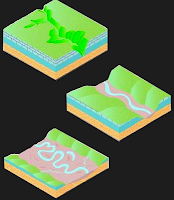 |
| Gallatin River |
A river's source is a lake, a spring, or a series of small streams or headwaters. All rivers flow downhill from their source. Rivers typically terminate in the ocean.
Would we need to trace a water molecule to know that water flowing through a river is never the same water?A river's life is significantly longer than a human generation. Seen over the course of a human lifetime, a river swells or shrinks seasonally and temporally, but in the aggregate, seems steady in course and flow.
"I thought how lovely and how strange a river is. A river is a river, always there, and yet the water flowing through it is never the same water and is never still. It’s always changing and is always on the move. And over time the river itself changes too. It widens and deepens as it rubs and scours, gnaws and kneads, eats and bores its way through the land."
― Aidan Chambers, This is All: The Pillow Book of Cordelia Kenn
On a geologic time scale, a river has a dramatic life-cycle.
Youthful
A youthful river has a steep gradient. It has rapid flow and has few tributaries. The steep gradient causes erosion that is deeper rather than wider.
Mature
Mature rivers have a milder gradient and slower flow. It is fed by many tributaries and has a greater volumetric flow rate. The milder gradient causes erosion that is wider rather than deeper.
Old
An old river has a low gradient and low erosive energy. Old rivers are characterized by flood plains.
Eventually, all things merge into one, and a river runs through it.
Mississippi River
― Norman Maclean, A River Runs Through It




